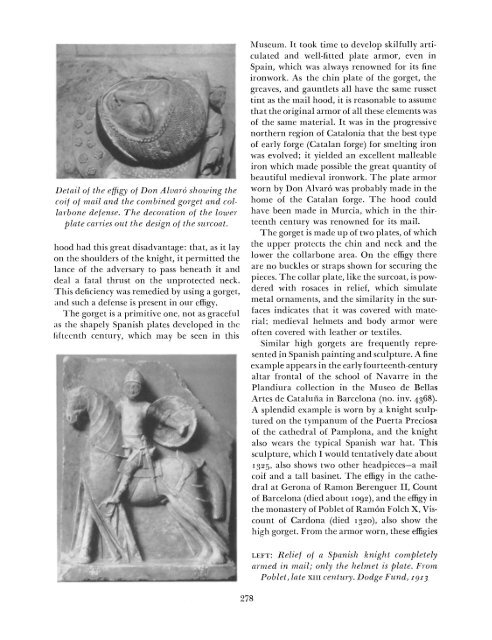OF DON ALVARO CABRERA - Metropolitan Museum of Art
OF DON ALVARO CABRERA - Metropolitan Museum of Art
OF DON ALVARO CABRERA - Metropolitan Museum of Art
Create successful ePaper yourself
Turn your PDF publications into a flip-book with our unique Google optimized e-Paper software.
Detail <strong>of</strong> the effigy <strong>of</strong> Don Alvaro showing the<br />
coif <strong>of</strong> mail and the combined gorget and col-<br />
larbone defense. The decoration <strong>of</strong> the lower<br />
plate carries out the design <strong>of</strong> the surcoat.<br />
hood had this great disadvantage: that, as it lay<br />
on the shoulders <strong>of</strong> the knight, it permitted the<br />
lance <strong>of</strong> the adversary to pass beneath it and<br />
deal a fatal thrust on the unprotected neck.<br />
This deficiency was remedied by using a gorget,<br />
and such a defense is present in our effigy.<br />
The gorget is a primitive one, not as graceful<br />
as the shapely Spanish plates developed in the<br />
fifteenth century, which may be seen in this<br />
<strong>Museum</strong>. It took time to develop skilfully articulated<br />
and well-fitted plate armor, even in<br />
Spain, which was always renowned for its fine<br />
ironwork. As the chin plate <strong>of</strong> the gorget, the<br />
greaves, and gauntlets all have the same russet<br />
tint as the mail hood, it is reasonable to assume<br />
that the original armor <strong>of</strong> all these elements was<br />
<strong>of</strong> the same material. It was in the progressive<br />
northern region <strong>of</strong> Catalonia that the best type<br />
<strong>of</strong> early forge (Catalan forge) for smelting iron<br />
was evolved; it yielded an excellent malleable<br />
iron which made possible the great quantity <strong>of</strong><br />
beautiful medieval ironwork. The plate armor<br />
worn by Don Alvaro was probably made in the<br />
home <strong>of</strong> the Catalan forge. The hood could<br />
have been made in Murcia, which in the thirteenth<br />
century was renowned for its mail.<br />
The gorget is made up <strong>of</strong> two plates, <strong>of</strong> which<br />
the upper protects the chin and neck and the<br />
lower the collarbone area. On the effigy there<br />
are no buckles or straps shown for securing the<br />
278<br />
pieces. The collar plate, like the surcoat, is pow-<br />
dered with rosaces in relief, which simulate<br />
metal ornaments, and the similarity in the sur-<br />
faces indicates that it was covered with mate-<br />
rial; medieval helmets and body armor were<br />
<strong>of</strong>ten covered with leather or textiles.<br />
Similar high gorgets are frequently repre-<br />
sented in Spanish painting and sculpture. A fine<br />
example appears in the early fourteenth-century<br />
altar frontal <strong>of</strong> the school <strong>of</strong> Navarre in the<br />
Plandiura collection in the Museo de Bellas<br />
<strong>Art</strong>es de Catalufia in Barcelona (no. inv. 4368).<br />
A splendid example is worn by a knight sculptured<br />
on the tympanum <strong>of</strong> the Puerta Preciosa<br />
<strong>of</strong> the cathedral <strong>of</strong> Pamplona, and the knight<br />
also wears the typical Spanish war hat. This<br />
sculpture, which I would tentatively date about<br />
1325, also shows two other headpieces-a mail<br />
coif and a tall basinet. The effigy in the cathedral<br />
at Gerona <strong>of</strong> Ramon Berenguer II, Count<br />
<strong>of</strong> Barcelona (died about 1092), and the effigy in<br />
the monastery <strong>of</strong> Poblet <strong>of</strong> Ram6n Folch X, Viscount<br />
<strong>of</strong> Cardona (died 1320), also show the<br />
high gorget. From the armor worn, these effigies<br />
LEFT: Relief <strong>of</strong> a Spanish knight completely<br />
armed in mail; only the helmet is plate. From<br />
Poblet, late xiII century. Dodge Fund, I913

















